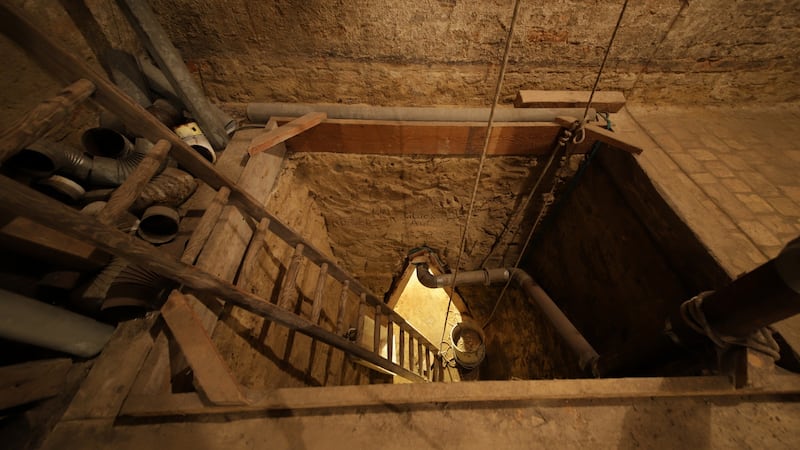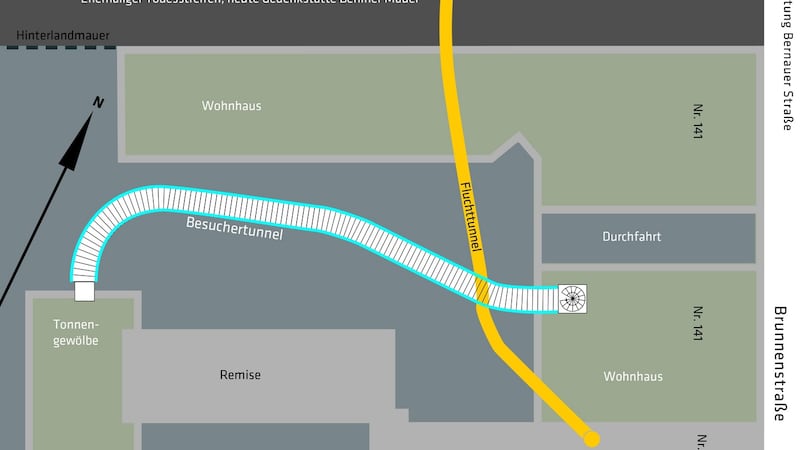The ragged opening in the sandy Berlin soil looks less like an escape tunnel and more like a ghostly, passage grave. For four decades it sat under the contested soil of cold war Berlin. Only now, as Germany marks the 30th anniversary of the fall of the Berlin Wall, has the tunnel from 1971 been rediscovered and reopened for curious visitors.
"The people who worked here digging in the cellar were here full-time, not allowed out for security reasons, three shifts a day of eight hours each," said Ulrich Pfeiffer, who was involved in planning the 1971 tunnel after fleeing to West Berlin a decade earlier.
After weeks of careful, covert planning three teams worked around the clock for nine weeks to reach the other side. But 10 metres before the end, the tunnel was discovered by the Stasi secret police and border guards. Several of the 17 people scheduled to flee with the tunnel were arrested and served prison time.
The original tunnel can be viewed by visitors to a new underground tunnel that opened on Sunday. It was built by a local Berlin organisation Berliner Unterwelten that specialises in protecting and renovating wartime and cold-war infrastructure such as tunnels and bunkers.
"The escapes through tunnels were really spectacular and, for me, the people who built them are heroes," said Dietmar Arnold, head of Berliner Unterwelten. "Those involved were aware of the risk but if a tunnel escape succeeded then many people got to the west, an unbelievable feeling of happiness for those involved in the escape."
At least 75 escape tunnels were built under the wall during the 28 years it stood in Berlin. Just 19 were successful, helping about 300 flee to the west.
Many were built in the area around the Bernauer Strasse: once a no-man’s-land and now the official memorial that hosted official ceremonies on Saturday to mark the wall anniversary and honour its 140 victims.

Few visitors to the open-air memorial notice the square metal plates in the grass beneath their feet. Or if they do notice them, they may not realise why they stretch in lines perpendicular to the remainders of the Berlin Wall.
Each series of metal plates represents the route of an escape tunnel out of the socialist east.
At least 10 were built in this area but just three were used for successful escapes. Many were betrayed, others struggled with the poor soil and engineering difficulties. Berlin is a difficult place to build a tunnel: most of the soil is sandy and unstable and the city was built on a swamp, with ground water just three metres below the surface.
The first well-known tunnel here was dug by West Berlin students in 1962 and began in the basement of a factory ruin at Bernauer Strasse 78 across to the basement of Schönholzer Strasse 7 on September 14th, 1962. Over two nights, 29 people managed to crawl through mud and leaking water to escape to West Berlin, where a film crew from US broadcaster NBC captured their arrival.
The most successful – and tragic – was Tunnel 57. It was built by 30 West Berlin students who started digging under an abandoned bakery and continued for 140m longer than a football pitch. The escape began on October 3rd, 1964, with 28 people told to come to Strelitzer Strasse 55 at 15-minute intervals and give the password: “Tokyo”, after the host city of that year’s Olympic Games.
The escapees – men, women and three children – squeezed through the tunnel measuring just 1m x 80cm. On the second night two strangers appeared, who didn’t know the code word. They begged to be let through and said they were going to get a friend.
As 29 people squeezed through the two men returned with border guards and Stasi officers. Escape helper Christian Zobel saw them approaching and, in a scuffle, opened fire on border guard Egon Schultz who later died.
Only after 1989 did Stasi secret police files show that that Schultz, though wounded by Zobel, was actually killed by friendly fire from a fellow guard’s Kalashnikov machine gun.
East German authorities suppressed those facts, condemned the “cowardly” attack and demanded Zobel’s extradition. Ignoring West German prosecutors’ requests for Schultz’s autopsy files, East Berlin created a hero cult around the dead soldier, with parades and streets named after him. Zobel died in 1992, still believing he had killed a man.
"He never came to terms with the situation, he became an alcoholic, it pursued him all his life," said Ralph Kabisch, whose idea it was to build the escape tunnel.
By 1970, the Stasi had grown more sophisticated in policing the wall and built their own tunnel, parallel to the wall, to intercept any new diggers.

Pfeiffer believes the 1970/1971 tunnel was discovered using special ultrasonic microphones that could pick up the sounds of shovels through the soil. Files suggest the Stasi took delight in letting the diggers continue their work, only to intervene at the last minute to collapse it.
A picture from 1971, taken by the Stasi, shows Pfeiffer standing on a lookout post on the West Berlin side of the wall, watching with a solemn face as the tunnel is destroyed.
“It was clear all our work had collapsed, we were unbelievably annoyed and depressed,” said Pfeiffer.
Now 84, he hopes the new Berlin tour, including glimpses of the abandoned tunnel, will encourage younger visitors to stand up to injustice in their own lives.
“You could either be passive towards that s**t regime, or stand up to it by being active,” he said. “It was a good way of releasing anger towards this illegitimate state which chose to lock in its citizens.”












